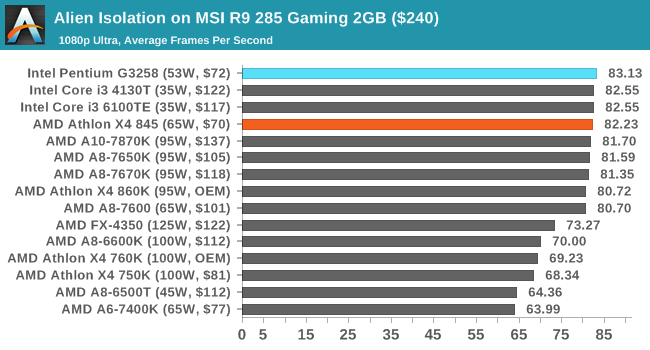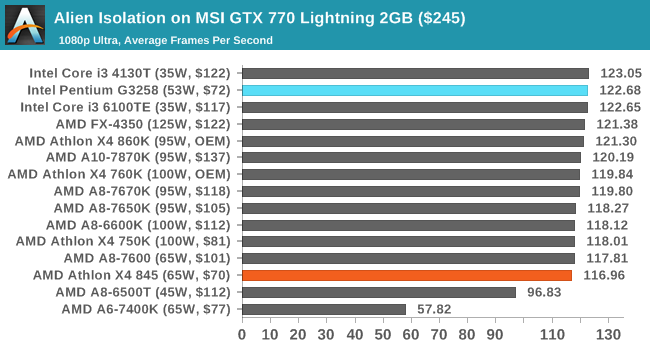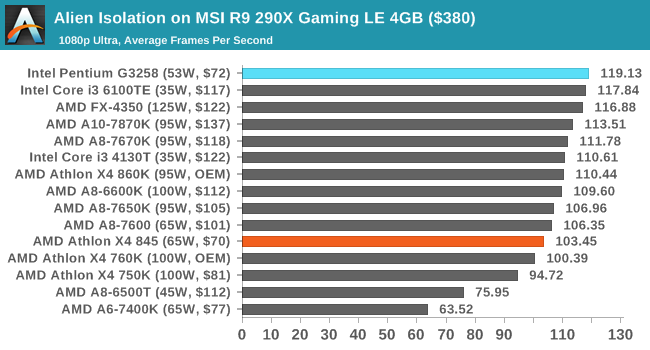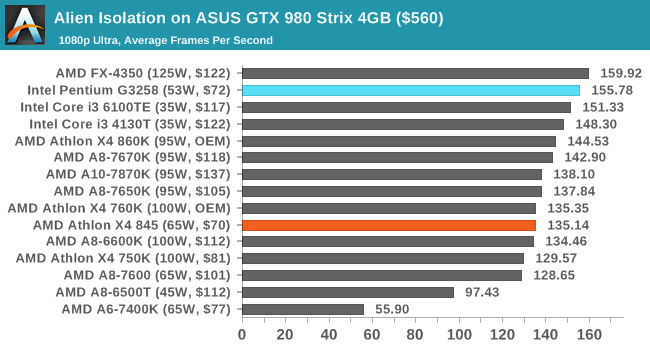AMD Carrizo Part 2: A Generational Deep Dive into the Athlon X4 845 at $70
by Ian Cutress on July 14, 2016 9:00 AM ESTAlien: Isolation
If first person survival mixed with horror is your sort of thing, then Alien: Isolation, based off of the Alien franchise, should be an interesting title. Developed by The Creative Assembly and released in October 2014, Alien: Isolation has won numerous awards from Game Of The Year to several top 10s/25s and Best Horror titles, ratcheting up over a million sales by February 2015. Alien: Isolation uses a custom built engine which includes dynamic sound effects and should be fully multi-core enabled. We take the average frame rate as our marker with a scripted version of the built-in benchmark.
For this test we used the following settings with our graphics cards:
| Alien Isolation Settings | |||
| Resolution | Quality | ||
| Low GPU | Integrated Graphics | 1280x720 | Ultra |
| ASUS R7 240 1GB DDR3 | |||
| Medium GPU | MSI GTX 770 Lightning 2GB | 1920x1080 | Ultra |
| MSI R9 285 Gaming 2G | |||
| High GPU | ASUS GTX 980 Strix 4GB | 1920x1080 | Ultra |
| MSI R9 290X Gaming 4G | |||




Alien Isolation in this case favors a higher IPC, and so as a result the Intel processors are quite high on the list. The biggest differences are when using the high-end graphics cards: the R9 290X and the GTX 980, which give a 10-20% increase in favor of the Pentium.











131 Comments
View All Comments
The_Countess - Tuesday, July 19, 2016 - link
actually bulldozer on 14nm would have been a completely different beast. it would have allowed AMD to use far more transistors per core while still making it way smaller in terms of size. that would have allowed AMD to create a far wider execution core, eliminating most of its bottlenecks.the high latency cache would probably still means it wouldn't be great for games but for everything else it would be a far more competitive design.
it is also 14nm that will allow zen to make such a massive leap in IPC's as it will be a very wide Core, while still being pretty small, something that just can't be done on 28nm.
bulldozer might not have been the best idea, but being stuck on 32/28nm for so long made all it's issues infinitely worse.
nandnandnand - Thursday, July 14, 2016 - link
"Well better late than never for Andantech,"There was no point in Adanantech writing this review, because it is a chip for those people too stupid to wait until Zen. Zen is the only thing that matters.
BurntMyBacon - Friday, July 15, 2016 - link
@nandnandnand: "There was no point in Adanantech writing this review, because it is a chip for those people too stupid to wait until Zen. Zen is the only thing that matters."Now, because this review exists, people as yet uninformed have concrete data to avoid decisions that might make them look (as you put it) stupid. There is very much a point.
Byte - Thursday, July 14, 2016 - link
Zen will probably be the RX480 in the CPU world. Better performance, still trounced by the competition, but competently priced.looncraz - Friday, July 15, 2016 - link
That would be an improvement on the current situation. AMD is pricing their CPUs quite poorly right now.An Intel Celeron G3900 is $50 right now. AMD's closest competition is the A6-7400k - at $55.
Both are dual cores, both are 65W, both have middling (but usable) graphics performance... quite similar at first glance... except the Intel runs at 2.8Ghz and the AMD runs at 3.5Ghz w/ 3.9Ghz turbo and can rather easily exceed 4Ghz when overclocked.
Sounds like AMD should be taking home the gold on that one, until you find that the Celeron is nearly 25% faster in single threaded programs and is ~40% faster in multi-threaded programs... Bad deal going for the AMD... especially since the same board that hosts the Celeron can accept much faster CPUs and the AMD board simply doesn't have notably more powerful options available - you can upgrade to a quad core, but you won't be getting better single threaded performance no matter how hard you try. You might break even around 5Ghz, if you can manage it...
AMD has a 40% clock-speed advantage out the gate, but loses by a large margin.
bananaforscale - Friday, July 15, 2016 - link
You know what's funny? The fact that if I want to get a CPU that's faster than the FX-6100 I bought almost 5 years ago I still have to pay more than what I paid for it. Sure, Intel gives better single thread performance but I'd get fewer cores and no overclockability. Then there's the fact that I've been running that original Bulldozer with a 20% OC and it seems more stable than at stock clocks.Comparing single data points tells nobody a thing. Anyway, isn't that A6 in your comparison unlocked? :P
wumpus - Friday, July 15, 2016 - link
I'm sure you missed an FX-8320 sale, or you really nailed the low point. Unfortunately Intel can match AMD's performance at nearly the same price, and is cutting off AMD's air supply that way.artk2219 - Monday, July 18, 2016 - link
Whats crazy is that Microcenter sells the FX 8320E's for $89.99. They also have a motherboard bundle option that you can get for $125 to $170 depending on which board you choose. Theoretically you can get a processor, motherboard, cooler, and memory for the price of a non-K core I5, or just a motherboard and processor for the price of an I3. The unfortunate thing is that not everyone has a microcenter near them, but for the ones that do you can get quite the deal, especially since those 8320E's will easily OC to FX 8350 levels, and more likely 4.2 to 4.6 from a stock clock of 3.2BlueBlazer - Friday, July 15, 2016 - link
From the leaks plus AMD's vague announcements, all points to AMD's Zen is going to be quite late (right into 2017). Why put use 28nm "placeholder" for AM4 if Zen is due soon? Also Global Foundries only has 14nm LPP which is a low power process. That may mean the frequency is going to be low (just look at the chips made on 14nm LPP like Qualcomm's Snapdragon 820, or even AMD's latest Radeon RX480). Reference http://semiengineering.com/high-performance-and-lo... quote "The “LP” processes are optimized for low power and feature design rules targeted for the lowest leakage, support lower operative voltages, and tend to have the slowest transistors of the three options".wiboonsin - Sunday, November 12, 2017 - link
I have read your article, it is very informative and helpful for me.I admire the valuable information you offer in your articles. Thanks for posting http://www.fanaticrunningwear.com/